Contents
- Pricing & Availability
- What comes in the box?
- Design & Construction
- Size & Measurements
- User Interface
- Emitter & Beam
- Mode Chart
- Runtime
- Driver & Regulation
- Switch
- Carry & Ergonomics
- Batteries & Charging
- Competition
- Conclusion
Pricing & Availability
In exchange for an honest review, Nitecore sent me this light at my request. Here is the official product page where you can see current pricing.
What comes in the box?
MT2A comes in a retail-ready box with typical construction, but the printing looks great. The black and yellow really stand out against all the plain white flashlight boxes I’ve opened recently from Olight and Sofirn.
- The light itself
- Battery (inside the light)
- User manual
- USB A-to-C charging cable
- Wrist lanyard
- Pocket clip
- Spare O-ring
Design & Construction
This is a traditional and conservative penlight design. The milling on the body tube adds a bit of grip and style.
Build quality is great. It feels well made and the finish is just right. Not too glossy, not too chalky.
Size & Measurements
Surefire G2X | Skilhunt MiX-7 | Skilhunt H300 | Sofirn IF24 | Nitecore MT2A Pro | Mini Maglite | Olight Warrior 3S | Olight Javelot

Wurkkos WK02 | Olight Warrior 3S | Nitecore MT2A Pro | Nitecore MT2A | Convoy S2+

| Measurement | Measured (mm) |
|---|---|
| Bezel Diameter | 19.8 |
| Maximum Head Diameter | 19.8 |
| Length | 142.0 |
| Switch Diameter | 12 |
| Switch Proudness | 0-5.5 |
| Lens Thickness | U/M |
| Lens Diameter | U/M |
| Reflector Hole Diameter | U/M |
| Reflector Diameter | U/M |
| Reflector Height | U/M |
| MCPCB Size | U/M |
| LED Footprint | U/M |
| Body Tube Diameter | 17.2 |
| Pocket Clip Slot Width | 5.2 |
| Pocket Clip Slot Diameter | 17.5 |
| Tailcap Diameter | 19.6 |
| Tailcap Length | 26.0 |
| Driver Diameter | U/M |
| Included Battery Length | 99.6 |
Flashlight weight: 40g
Included battery weight: 48g
Pocket clip weight: 5g
Total: 93g
User Interface
This is a dead simple UI. There’s no learning curve and nothing to trip you up. It’s a huge improvement over MT2A’s UI.
How it works: Click to turn the light on/off. When it’s on, half-press the switch to change modes. Turning it off and back on quickly works too. There are three brightness levels on the included battery and two on two AAs. It has mode memory, so it will turn on in your last mode. There are no shortcuts, blinky modes, or customization options.
What I like: It’s simple without any blinky modes or customization options. It’s easy to put too much functionality into a flashlight UI. This is a penlight so it doesn’t need a bunch of bells and whistles.
What I don’t like: The mode memory means I can’t turn it on straight to Low. On lights with clicky switches, I prefer the lowest mode to always come on first and then I can quickly tap into the mode I want to use. I also think it’s odd that using AA batteries eliminates one of the modes and changes the brightness of the other two.
Emitter & Beam

This light has a “NiteLab UHi 20” LED. I suspect most “NiteLab” LEDs are the same unbranded round die emitters being used in lights from other manufacturers, just with “NiteLab” printed on the packaging. Regardless, this is a small and intense LED that should provide a lot of throw. I wasn’t able to access it to get a measurement, but it looks 5050 sized. I would have liked a warmer, high-CRI option as well. Perhaps an SFT40 4000K will fit if/when it’s released.

The hotspot is just lovely. It’s relatively narrow, even, and crisp at the edges. The corona is not so great. There’s a large, dark-ish ring around the hotspot. It’s not too bad and it’s only noticeable on smooth, white surfaces like the wall above. The spill is plenty bright for peripheral illumination. Overall the beam is good, but I don’t like that dark ring.
In the beamshots below, the basketball goal to the right of the hotspot is 39M away and the power pole in the center is 185M away.






Mode Chart
Disclaimer: All of my measurements are taken at turn-on. Lumen measurements were taken on a Texas Ace 3.5″ Lumen Tube. A candela measurement was taken at 10 meters with an Opple Light Master III on the highest brightness, and other candela figures were calculated relative to that. CRI, CCT, & DUV data were taken for each mode from a few feet away at the center of the hotspot with the Opple Light Master and Waveform DUV Calculator. Runtime tests were performed with the Ceilingbounce app on my smartphone. These tests were performed with a fully charged included battery unless otherwise specified. I cannot measure moonlight directly, so moonlight readings are calculated based on the brightness relative to the next-lowest mode. None of this is professional equipment, so take these measurements with a grain of salt.

Above are the official specs, followed by my own measurements below.
| Level | Lumens | Candela | Throw (Meters) | CRI (Ra) | Color Temp. (K) | DUV (Tint) |
| High | 790 | 15000 | 245 | 66 | 6338 | 0.0080 |
| Medium | 280 | 5316 | 146 | 64 | 5980 | 0.0114 |
| Low | 60 | 1139 | 68 | 63 | 5860 | 0.0130 |
| High (NiMH) | 470 | 8924 | 189 | N/M | N/M | N/M |
| Low (NiMH) | 69 | 1310 | 72 | N/M | N/M | N/M |
Mode Spacing is poor. The lowest mode (60lm) is far too bright and there’s insufficient space between the three modes. I think 50-100lm is a good brightness for Medium mode, and Low should be around 1 lumen. On AAs the mode spacing is better, but it still lacks a sufficiently low mode.
Runtime

Performance is excellent. Sustained brightness and total runtime are great on all the modes I tested. I’m particularly impressed with Medium mode which stayed perfectly flat at ~275lm.
Thermal regulation is present and works great. My Turbo Cooled test (fan blowing on the light) shows a dramatic increase in sustained brightness with active cooling.
LVP (Low Voltage Protection): MT2A Pro relies on the battery’s built-in protection circuitry to shut off before it’s over-discharged. It doesn’t appear to have low voltage protection built into the driver. That means after the battery shuts itself off, you won’t be able to re-activate the light unless you swap or recharge the battery.
Driver & Regulation
I’m not sure what kind of driver this is. I think it has a boost circuit since it manages to run a (presumably) 3V LED off two NiMH AA cells (as little as ~2.2V). I suspect it runs linear when you use the included battery.

Regulation performance: Normally I test regulation down to 3.0V, but at that voltage the light thinks it’s running on two AAs so it changes the modes. Other than that quirk, regulation performance is great. Brightness are unaffected by cell voltage until High dips a bit at ~25% charge. That’s exactly what I like to see. That tells me Nitecore is using good quality components and they’re pushing those components to get as much performance as possible.
Note: All regulation measurements are taken at turn-on so they do not reflect any thermal or low voltage stepdowns that may occur. A value of 0 indicates low voltage shutoff immediately upon activation.
PWM: No PWM is visible to my eyes, but I can hear faint whining coming from the tailcap on Low and Medium modes. My Opple was able to detect some flickering on those modes as well, but it’s not PWM. My phone camera couldn’t detect any flickering.
Parasitic Drain: There is no parasitic drain because this light uses a mechanical switch.
Switch

The switch is a mechanical reverse clicky. It’s covered by a rubber boot and protected by two ears on the tailcap that make it a little tricky to press sometimes. The chances of it coming on by accident are slim to none. Since it’s a reverse clicky, you can change the mode without fully clicking the light off. However, there’s no momentary-on function.
I wish the switch were a forward clicky with no protective ears around it and no mode memory in the UI. Then I’d be able to momentarily activate it without fully clicking the light on. I’d have direct access to the lowest mode and I’d be able to quickly tap-tap to the highest mode in an instant. I have other lights set up that way and it works very well. This switch/UI feels a little cumbersome by comparison.
Carry & Ergonomics
Ergonomics are great. This 2xAA shape with a tailswitch fits in the hand so well. The milling on the body tube adds grip without being rough. It’s super comfortable to use in either a reverse or cigar grip. My only gripe is the ears on the tailcap that protect the switch. They do their job a little too well and make it difficult to press the switch sometimes. They also allow the light to tailstand, but I think switch access is more important.
The clip is fine but it could use some tweaks. The mouth is a little small so sometimes I have to lift the clip to pocket the light. Where it comes off the body of the light, it sticks out really far before bending upward. My pants pocket won’t go up past that ledge because it’s so big and the loop above it is so small. I think the right height is appropriate. It’s not “deep carry” but the light doesn’t stick out of the pocket much.
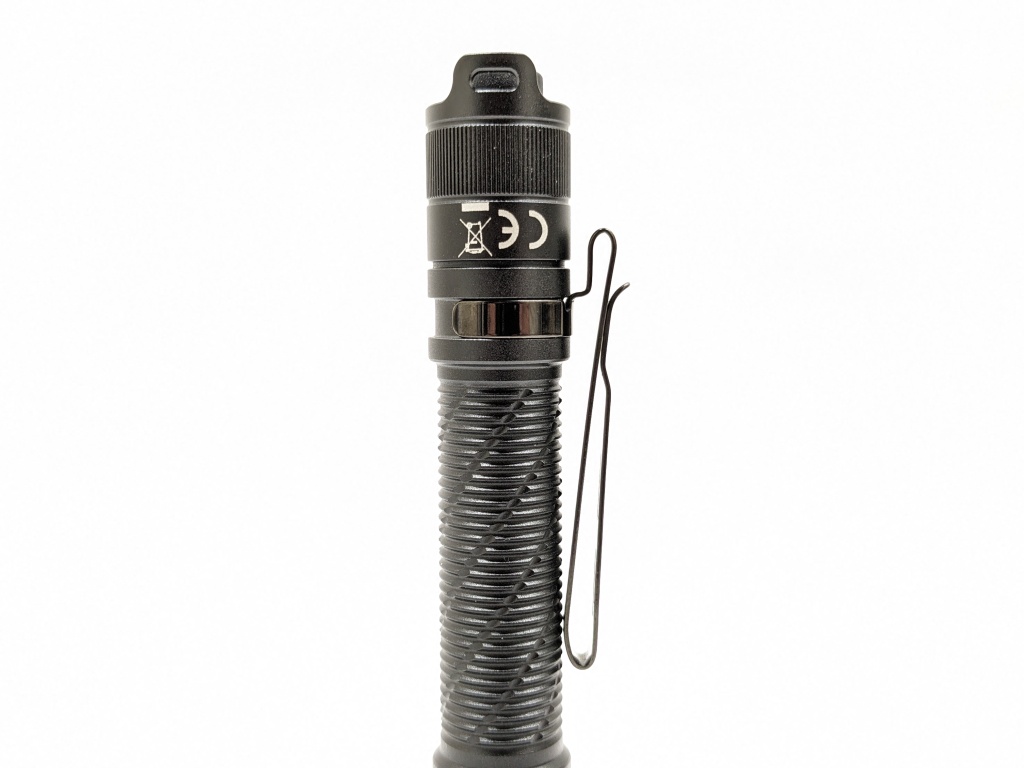
A basic wrist lanyard is also included in the box and can be attached to the ears on the tailcap or the holes on the pocket clip.
Batteries & Charging

The battery is a single Li-ion cell that’s the same size and shape as two stacked AAs and it has a USB-C port on one end for charging. It can also accept two AAs in a pinch. This is a great way to make the light easy to recharge day-to-day and retain the ability to swap batteries with common disposables in a pinch. NiMH cells work too. Charging is pretty slow and there’s a red/green LED near the USB port to indicate charging (red) or fully charged (green).

Competition
Here are some lights in the same class and how they compare.
- less expensive
- no batteries nor pocket clip included
- larger
- wide variety of LED options
- supports 2×14500 and 2xAA (Alkaline, NiMH, Lithium)
- three body color options
- metal button
- slow shipping
- customizable user interface
- lower street price
- two LED options (including Nichia 519A)
- two modes, always starts on low
- poor regulation
- lackluster forward clicky switch (weirdly stiff and has a delay)
- similar price
- cleaner aesthetic
- similar performance (on 2xAA)
- no batteries included
- more accessible, forward clicky switch
- simple two-mode UI, always starts on low
- three body colors and two milling patterns to choose from
- two LED options
- same odd “soft start” behavior on High mode when using AAs
- does not support 2×14500 cells, but I suspect a single long cell (like the Nitecore one in this review) would work
This section is not comprehensive. If I didn’t include a particular light here, it doesn’t mean it’s bad or doesn’t deserve to be here. I simply cannot list every possible competitor.
Conclusion
Pricing is in line with competetive models. The UI is simple and easy and distinguishes itself from the competition with mode memory. The emitter doesn’t have great color properties, but performance is great with best-in-class brightness and throw. Sustained brightness and runtime are both excellent. Mode spacing needs to be improved. It’s reasonably ergonomic and carries fairly well. The switch is a little hard to access and I wish it were a forward clicky. The included battery is perfect for daily use, and AAs can be used as a backup. Overall, Nitecore did a great job making a compelling 2xAA-size penlight and making it distinct from the competition.
Thanks to Nitecore for sending me this light for review!

















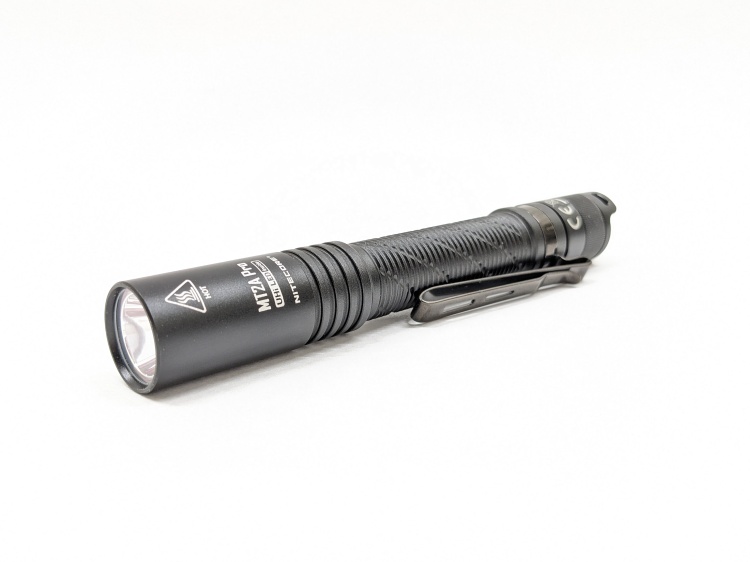




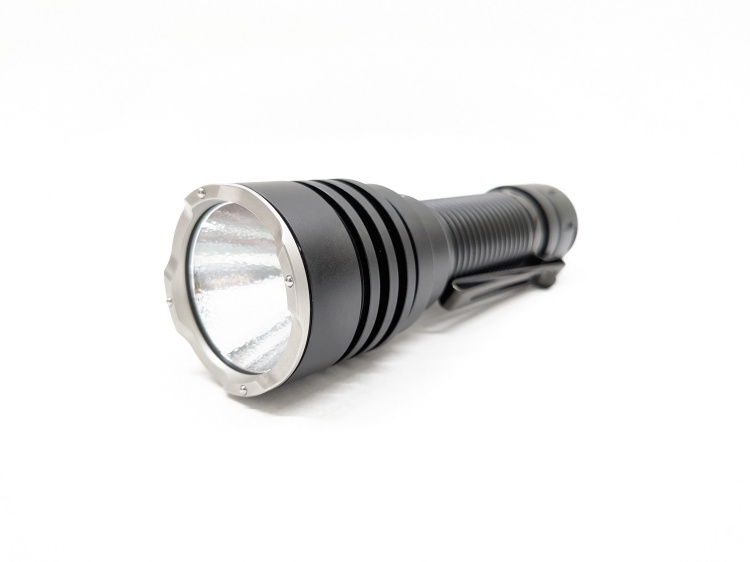

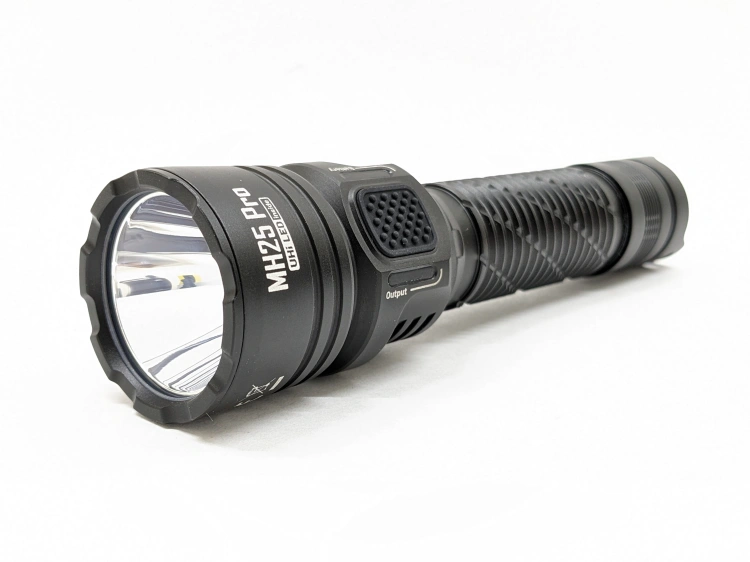


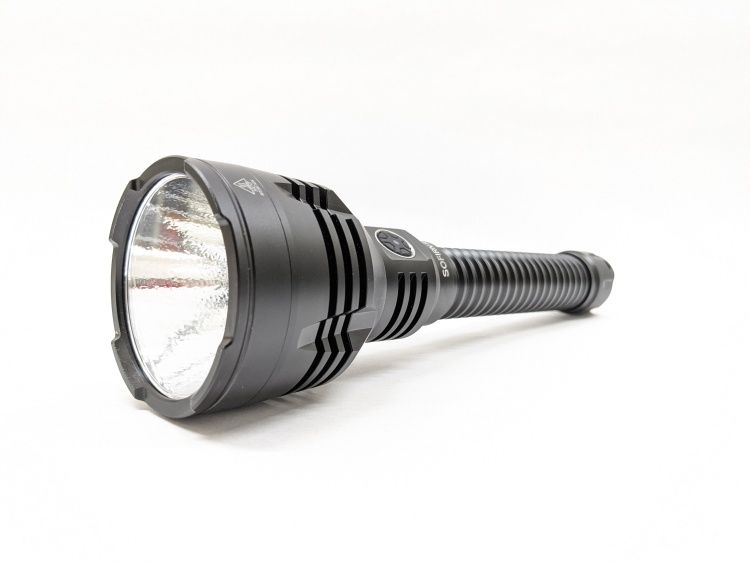
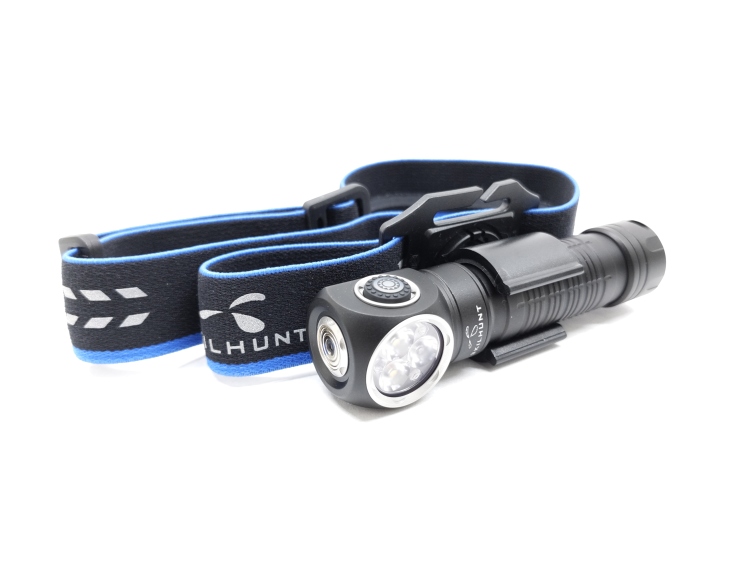
bonjour très belle critique, j’hésite en ce moment entre olight baton 3 pro et e nitecore en port edc quotidien, pouvez vous me conseiller ?
LikeLike